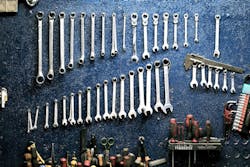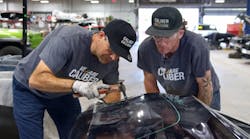Overhauling Heavy-Duty Collision Repair Guidelines
Chris Sterwerf worked part time at his father’s heavy-duty truck collision repair shop throughout high school and college. Now, the CFO and COO of Fairfield Auto & Truck Service Inc., Sterwerf has dedicated his time to fine-tuning shop processes.
The heavy-duty truck collision industry is years behind the auto collision industry, Sterwerf says. While laws like the Right to Repair bills for the motor vehicle industry have been in place for a few years, the heavy-duty industry is only now implementing the same laws. Because of this, bringing awareness and advocating for the heavy-duty truck segment is important for the industry and why Sterwerf has gotten involved heavy-duty taskforces. Sterwerf sat down with FenderBender to discuss the heavy-duty taskforces he joined with other independent shop owners.
One group—the Heavy-Duty Collision Repair Roadmap—is chaired by Joe Fassett, general manager of Al’s Automotive and Truck Service Center. The “roadmap” will be segmented by collision type, such as front end, rear, side, rollover and more.
Sterwerf is the chair of the second task force, Heavy Duty Collision Repair Guidelines. This group will develop recommendations to a program to include heavy-duty truck collision repair providers in the ATA Technology & Maintenance Council (TMC) and identify needs for repair providers to improve the safety, quality and reliability of service in heavy-duty truck collision repair.
How did this idea come about?
I started to become more involved in the heavy-duty truck collision repair industry three years ago. I attended a meeting at TMC. The meeting was one of the exploratory meetings about the industry where people can share topics. I asked to talk about a need I’d seen in the industry for repair procedures that can be held as a standard to OEM repair qualifications.
One of the great things about TMC is that it’s a monster organization. It’s a place where fleet managers, engineers and manufacturing companies get together. Right now there are heavy-duty truck mechanical repair procedures in place but not a lot of collision repair procedures.
I needed to open the eyes of the organization that, even though collision repair is a small fraction of what the fleet and truck services pay out to, it can quickly add up when there are variations of repairs across every state.
For example, in the truck world, you’re not supposed to heat metal frame rails but there are some manufacturers that do heat the rails because it saves time and money in the repair process. Heating the metal can cause the molecules in the metal to change and become brittle and fracture. This could lead to catastrophic accidents that do, unfortunately, happen every day.
Why is this not done in the heavy-duty truck industry?
According to the heavy-duty truck Right to Repair Act, body shops can access repair procedures from OEMs on their websites. However, the links often do not work. In this case, the body shop can put in a service information request.
Yet, to my knowledge, only three service information requests have been filed by independent collision repair shops. And those three have been done by me in the last year.
What’s out there in procedures right now?
I-CAR does have repair procedures out there but I-CAR is mostly devoted to the light vehicle industry. There is a secondary level of information in place, but that can be dangerous in the truck world because the repairers are dealing with larger and heavier equipment.
The American Council of Frame and Alignment Specialists was a source for repair procedures but they’re a small group and have somewhat disbanded.
A shop also puts themselves at risk for liability when they don’t follow the OEM procedures.
When I spoke at the TMC exploratory meeting, some people had “ah-ha” moments in the crowd. They just assumed that body shops should know how to repair the vehicles. I like to tell them now that if doctors attend meetings and conferences to keep up to date on how to fix humans when humans don’t change that much, why can’t truck body shops do the same? Especially when the body of trucks is changing more and has been for a long period of time.
How will these differ from the repair procedures OEMs have put out there?
TMC follows engineering practices for their repair procedures. There are roughly 5,000 pages of engineering documents that are highly scrutinized and regarded in the industry right now.
For example, TMC created repair procedures for how to repair the fifth wheel on the truck and this one repair procedure has long been used by OEMs. This document has also been used in the incidents of accidents involving the fifth wheel to prove or disprove shop liability.
How long will this process take?
In a perfect world with no roadblocks or bumps along the way, creating these repair procedures could take up to three semi-annual meetings that TMC holds.
We’re starting with easy repairs that have little controversy and won’t get voted down by the organization. We’ll create the repair document and have members of TMC advise and fix it, and then it goes to a ballot at the following meeting.
Could these reach across the industry?
Yes, insurance companies can use them. Fleet services can use them to vet shops. If a truck is damaged and only has a choice of going to an independent body shop, these documents could enable the fleet services to ask the right questions on the quality and time it will take for the repair.



